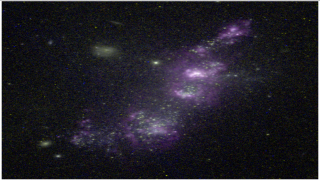Bibcode
Matthee, Jorryt; Sobral, David; Hayes, Matthew; Pezzulli, Gabriele; Gronke, Max; Schaerer, Daniel; Naidu, Rohan P.; Röttgering, Huub; Calhau, João; Paulino-Afonso, Ana; Santos, Sérgio; Amorín, Ricardo
Bibliographical reference
Monthly Notices of the Royal Astronomical Society
Advertised on:
7
2021
Citations
74
Refereed citations
67
Description
We present the first results from the X-SHOOTER Lyman α survey at z = 2 (XLS-z2). XLS-z2 is a deep spectroscopic survey of 35 Lyman α emitters (LAEs) utilizing ≍90 h of exposure time with Very Large Telescope/X-SHOOTER and covers rest-frame Ly α to H α emission with R ≍ 4000. We present the sample selection, the observations, and the data reduction. Systemic redshifts are measured from rest-frame optical lines for 33/35 sources. In the stacked spectrum, our LAEs are characterized by an interstellar medium with little dust, a low metallicity, and a high ionization state. The ionizing sources are young hot stars that power strong emission lines in the optical and high-ionization lines in the ultraviolet (UV). The LAEs exhibit clumpy UV morphologies and have outflowing kinematics with blueshifted Si II absorption, a broad [O III] component, and a red-skewed Ly α line. Typically, 30 per cent of the Ly α photons escape, of which one quarter on the blue side of the systemic velocity. A fraction of Ly α photons escape directly at the systemic suggesting clear channels enabling an ≍10 per cent escape of ionizing photons, consistent with an inference based on Mg II. A combination of a low effective H I column density, a low dust content, and young starburst determines whether a star-forming galaxy is observed as an LAE. The first is possibly related to outflows and/or a fortunate viewing angle, while we find that the latter two in LAEs are typical for their stellar mass of 109 M⊙.
Related projects

Starbursts in Galaxies GEFE
Starsbursts play a key role in the cosmic evolution of galaxies, and thus in the star formation (SF) history of the universe, the production of metals, and the feedback coupling galaxies with the cosmic web. Extreme SF conditions prevail early on during the formation of the first stars and galaxies, therefore, the starburst phenomenon constitutes a
Casiana
Muñoz Tuñón